It's nice to be back writing a post after a solid - but exhilarating - month's work in the south-west of far-off Western Australia, including an 8000 km return drive there and back. Part of that drive involves 'the crossing', still one of Australia's great driving experiences, though it's a lot easier now than when my parents did it on a dirt track back in 1947. 'The Nullarbor' is part of modern Australian folklore, though most of us would have trouble defining it. I think it's best to think of it as the vast limestone plain - the largest in the world - that stretches for some 2000km from west of Ceduna in South Australia nearly to Norseman in Western Australia (henceforth WA), covering a quarter of a million square kilometres. Others would define it more tightly as the treeless 'core' straddling the state borders. Some people even use the term very loosely to talk about the whole drive from Adelaide to Perth, but that doesn't bear close scrutiny.
The somewhat twee name Nullarbor was coined in 1866 by South Australian Surveyor Edmund Delisser, who crossed to the WA border and reported a vast treeless tract; being of the Victorian era he felt obliged to invent a Latin term which essentially means 'no trees'.
Coming from the east, we leave agricultural land in the vicinity of Nundroo, where beautiful mallees (multi-stemmed eucalypts of many species) form an overstorey over the bluebushes (saltbushes of the family Chenopodicaceae) which continue west when the trees end.
 |
| Eucalyptus calcareana (the name refers to the limestone habitat) over bluebush, Maireana spp., near Nundroo. |
The vast plateau we're driving across was laid down under a shallow sea - beneath the bitumen are the calcium-based shells and exoskeletons of billions of long-dead marine animals. Towards the state border the trees get fewer and the bluebush starts to take over.
 |
| Eastern edge of the plain, with only scattered trees now to break the horizon. |
Soon, even those trees disappear, and a variety of low shrubs begins to completely dominate.
 |
| Low teatrees - including Melaleuca spp. - above, and chenopods (especially bluebushes and saltbushes) below, forming the great treeless plains. |
Here the road is close to the shore of the Southern Ocean, forming the Great Australian Bight, and the line of the Bunda Cliffs, running for well over a hundred kilometres and up to 100 metres high, is one of the most superb seascapes in the country.
 |
| The magnificent Bunda cliffs, near the Head of the Bight (above and below). |
Virtually at the border, the cliffs begin to march inland.
 |
| The Bunda Cliffs leave the coast here, at the state border, so that there is now a coastal plain seaward of the plateau. |
At Eucla, just inside WA, the highway descends onto the Roe Plain, a broad coastal strip of ancient compacted dunes. For nearly 200km we drive along this plain, at the foot of the Hampton Plateau, until at the Madura pass we climb up onto the plateau again.
 |
| Two views from the top of the Madura Pass; above, looking east along the edge of the Hampton Plateau. Below, looking out towards the distant ocean across the Roe Plain. |
As can be seen from the photos above, the trees have by now returned to the landscape; again mallees dominate.
 |
| Eucalyptus socialis woodland near Caiguna, WA. |
Also near Caiguna is what is claimed to be the longest completely straight stretch of road - 146km without the slightest deviation - in Australia. (Some say the world, but I'm not claiming that! It does seem unchallenged however that the Transcontinental Railway to the north of the road is indeed the longest dead straight length of line - 480km of it.)
 |
| Start of the 146km straight, just west of Caiguna. |
As you'd expect with such an extensive karst system, limestone caves riddle the landscape, though most are not accessible to the public.
 |
| Sinkhole just outside of Caiguna. Some of the caves have produced some very important fossil troves, including the only complete skeleton of the formidable marsupial 'lion', Thylacoleo carnifex. |
Finally, near Balladonia, we enter the beautiful vast woodlands of the Goldfields area of WA, worthy of a posting in their own right one day.
If you get the chance to make the crossing, please do it one day (or rather, at least three days for the section discussed here!). I've done the return trip five times now, and I'm sure I'll be doing it again. If you're Australian, it's definitely an important part of the national experience. If you're visiting, it will also leave a deep impression on you. I think you'll agree with me that the experience has no need of such silly cheap gimmicks as an extended golf course - it's much too special in its own right.
BACK ON FRIDAY, TO TALK ABOUT SOME ANIMALS OF THE NULLARBOR, INDCLUDING ONE VERY SPECIAL ONE INDEED.





3 comments:
Welcome back. And what an evocative topic! I look forward to reflections on the rest of the voyage.
So it's the Australian equivalent of the Loire Valley? I had no idea! We wanted to do it the last time we visited Australia, but it just wasn't logistically possible. I've never done it and would love to.
Thanks Martin; I've now organised all my photos, so can post more on the rest of the trip in coming weeks.
Interesting analogy Susan, which I confess had failed to occur to me for some reason... You must build your next trip to Australia around that drive - I promise you won't regret it.
Post a Comment